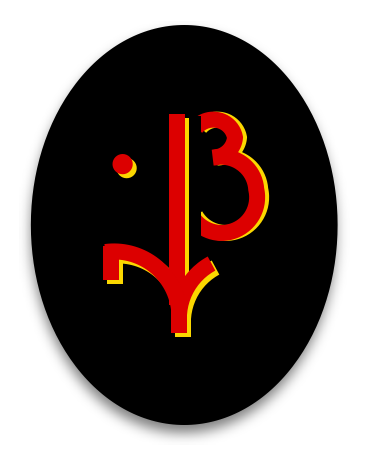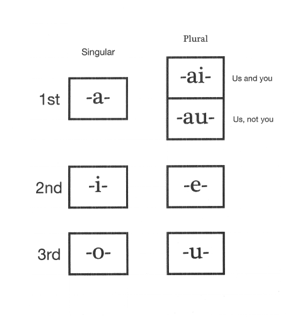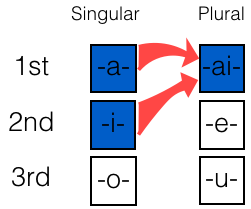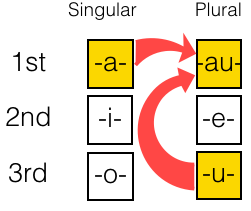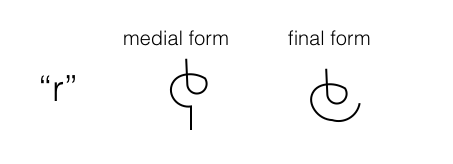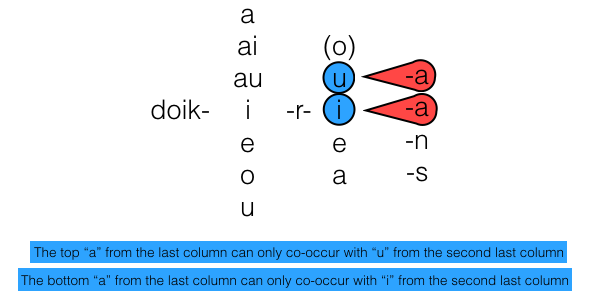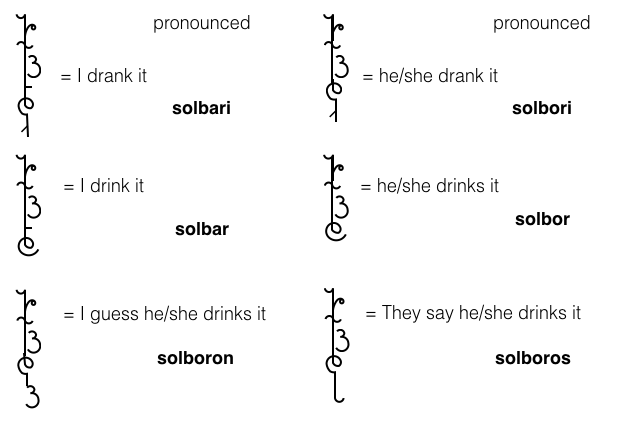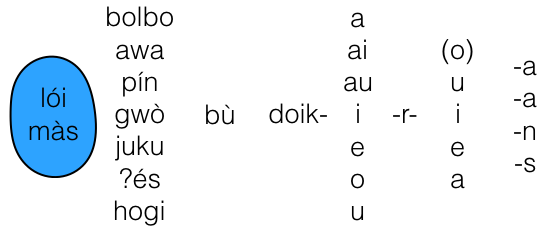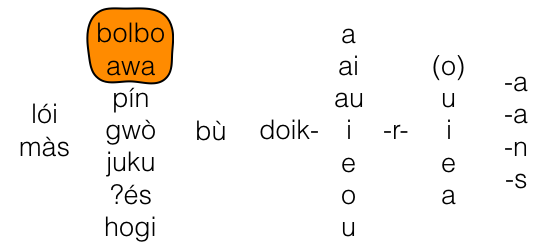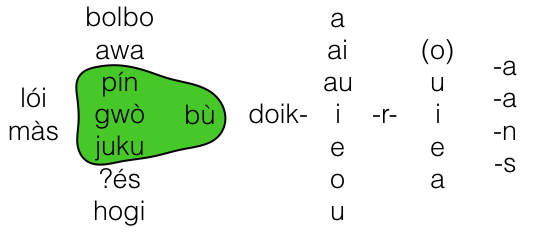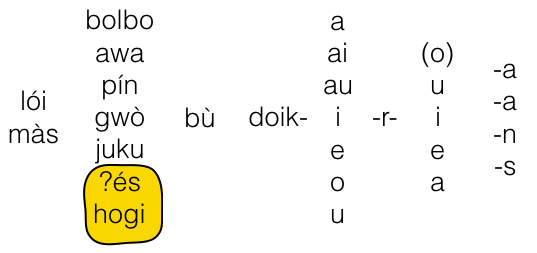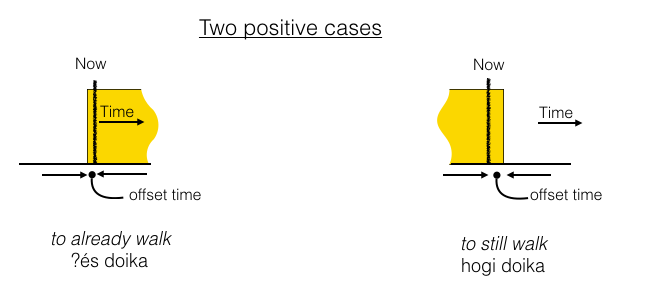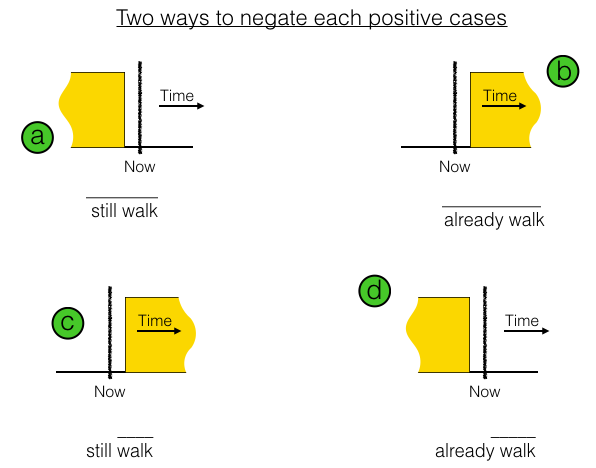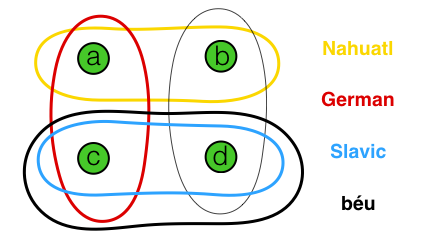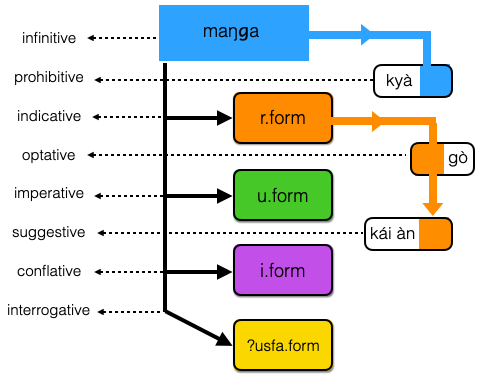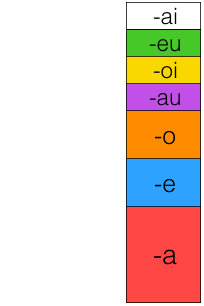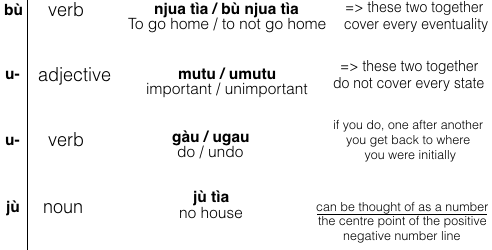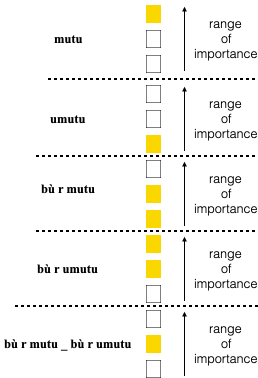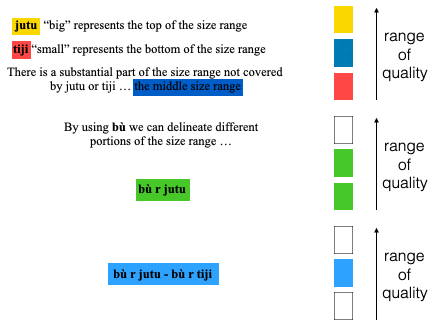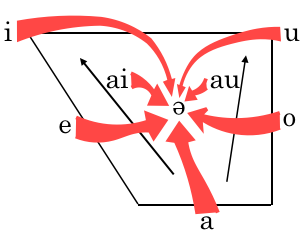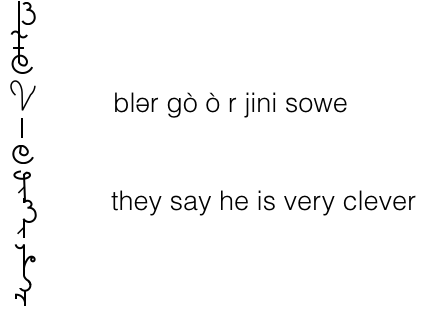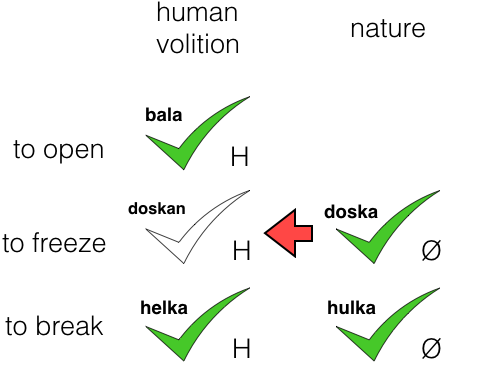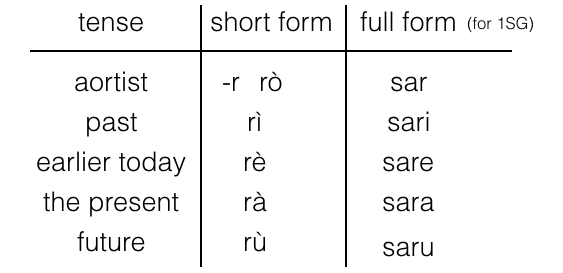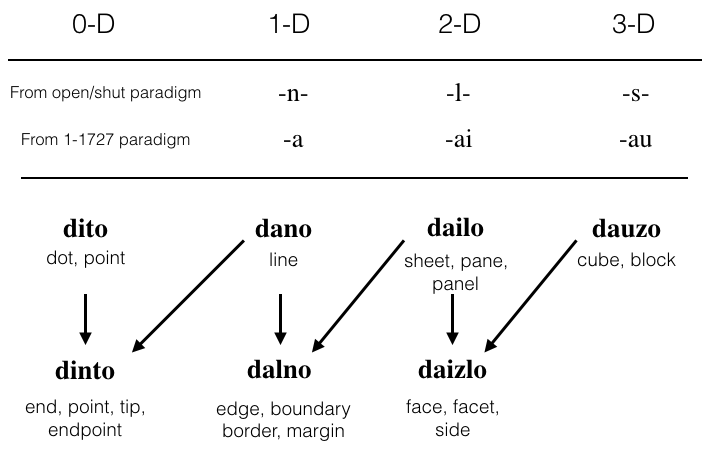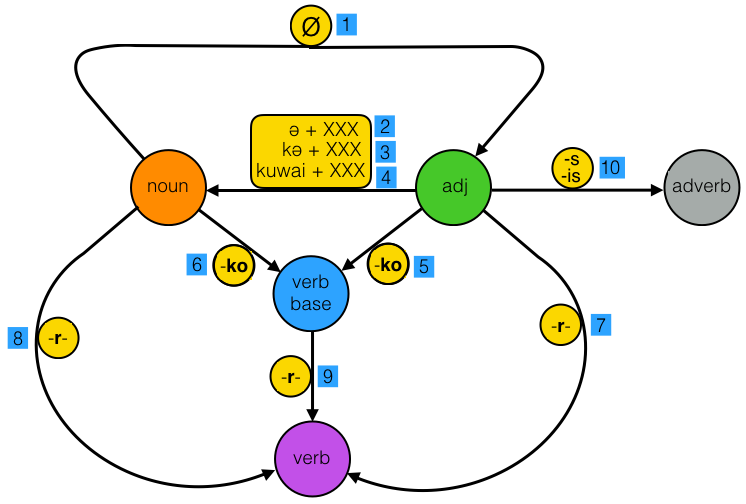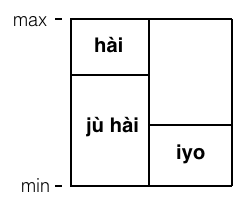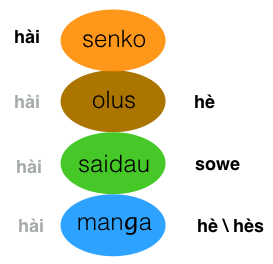Béu : Chapter 3 : The Verb
Contents
..... Person/Tense/Evidence
..
Also called the r-form or the indicative.
..
To make a verb in the indicative mood, you must first deleted the final vowel from the base form. Then add affixes that indicate "agent", "indicative mood", "tense", "evidentiality" and "perfectness". We will refer to these as slots 1, 2, 3, 4 and 5 respectively. All these affixes together are known as the verb tail. The "agent", "indicative mood", "tense" are mandatory ... however one tense, the aortist is a null morpheme.
..
... Seven Persons
..
Slot 1 is for the agent ..
One of the 7 vowels below is must be added. These indicate the doer..
Notice that there are 2 entries that represent the 1st person plural subject (i.e. we). The top one represents first person inclusive and the bottom one represents first person exclusive.
Some people might have difficulty remembering whether to use ai or au. The diagram below might help some ...
..
..
Mathematically it is as if ... ai = me + you ... and ... au = me + they ....... (sort of)
The vowels of the first person plural inclusive pronoun magi are reflected in the infix -ai-.
As are the vowels of the first person plural exclusive pronoun manu reflected in the infix -au-.
..
Note that the ai form is used when you are talking about generalities ... the so called "impersonal form" ... English uses "you" or "one" for this function.
The above defines the "person" of the verb. Then follows an "r" which indicates the word is an verb in the indicative mood. For example ...
doika = to walk
doikar = I walk
doikair and doikaur = we walk
doikir = you walk
doiker = you walk
doikor = he/she/it walks
doikur = they walk
..
... The R-form
..
One mood
..
Slot 2 is for the indicative mood marker.
..
At this point we must introduce a new sound and a new letter.
This letter has not been mentioned so far because it doesn't occur in any words as such. It only occurs in grammatical suffixes and it indicates the indicative mood.
If you hear an "r" you know you are hearing the main verb of a clause.
..
... Five Tenses
..
Slot 3 is for tense markers. There are 5 tense markers in béu
..
1) *doikaro => doikar = I walk (habitually)
This could be called "the open tense" ... timewise there are no limits to an action marked in this way. Also called "the timeless tense". A sort of habitual tense. Often used for generic statements. For example ...
ngur jwadoi = "birds fly"
Actually you can say this tense has an underlying o which appears again if there is an n or s in slot 4.
2) doikaru = I will walk
This is the future tense
3) doikari = I walked
This is the past tense. This means that the action was done before today (by the way ... the béu day starts at 6 in the morning).
4) doikare = I walked
This is the near-past tense. This means that the action was done earlier on today (a good memory aid is to remember that e is the same vowel as in the English word "day")
5) doikara = I am walking
This is the present tense ... it means that the action is ongoing at the time of speaking.
..
It can be seen that béu is more fine-grained, tense-wise than most of the world's languages ... http://wals.info/chapter/66 and http://wals.info/chapter/67
..
... Evidentials
..
Two Evidentials
..
Slot 4 can have one of the evidential markers a, a, n, s or it can be empty. Actually the first a defines the subjects attitute rather than any evidentiality, however all 4 are usually just called evidential markers.
..
There are three markers that cites on what evidence the speaker is saying what he is saying. However it is not mandatory to stipulate on what evidence you are saying what you are saying. In fact most occurrences of the indicative verb do not have an evidence marker.
The markers are as follows ...
1) -n
For example ... doikorin = "I guess that he walked" ... That is the speaker worked it out from circumstances/clues observed.
I will mention waron here. It means "I think so" and is nearly as common an answer as aiwa "yes"
2) -s
For example ... doikoris = "They say he walked" ....... That is the speaker was told by some third party(ies) or overheard some third party(ies) talking.
3) -a
For example ... doikoria = "he walked, I saw him" ...... That is the speaker saw it with his own eyes.
Note that the above evidential only co-occurs with the past tense and near-past tense. Actually when used with the near-past tense, *ea => ia so the distinction between "past" and "near-past" is lost for this evidential.
Now there is a forth possibility for this slot ... and it is not actually an evidintial. Furthermore it has the same form as 3).
4) -a
For example ... doikorua = "he intends to walk" ... the agent in this case must be a sentient being of course.
This evidential marker only co-occurs with the future tense.
If the speaker doesn't know the evidential or deems it unimportant then this slot can be left empty. According to corpus studies in béu, 60% - 70% of r-form have nothing in this slot.
..
So the complete verb prefix system is ...
..
It can be seen that the béu evidentiality inventory is quite substantial compared to other languages ... http://wals.info/chapter/78
Also it appears that 4 or 5 categories being appended to the verb is typical of languages of the world. See ... http://wals.info/chapter/22 [If I have understood the chapter properly]
..
... For brevity
..
We have seen that in the verb tail, o is not pronounced if it comes final (the aortist tense).
The reason for this is brevity of speech.
For brevity of writng, every occurrence of o is not written (in the verb tail). For example ...
..
..
... Probability/Aspect/Negation
..
We have already covered the 4 slots for "agent", r, "tense" and "evidentiality" at the end of the verb. As well as the nuances given by these suffixes, there are particles which add further information to the basic verb. These are called (near-standers ?). These particles occur in three pre-verbal slots.
The two particles in the first slot show probability.
The seven particles in the second slot have to do with aspect in some way. Aspect can be tricky.
In the third slot, only one particle : the negating particle bù.
..
... Two probability particles
..
..
lói = probably
màs = possibly
If nothing is in this slot, one assumes probability is 100% ... the option to challenge the underlying premise is never really considered.
The probability distribution for lói centres around 85 %.
The probability distribution for màs centres around 50 %.
One can indicate a probability distribution centred around 15 % by using lói + bù. For example ... lói bù doikor = He/she probably doesn't walk.
..
... Two habituality particles
..
..
Every verb can be considered to have a default probability distribution over time.
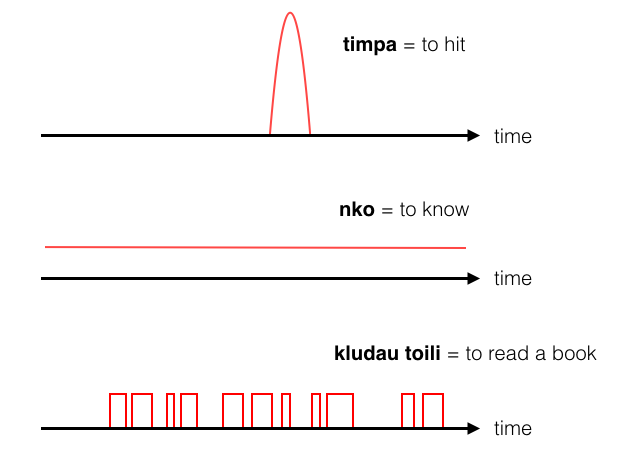 .... By the way, don't worry too much about the time scale in these sketched.
.... By the way, don't worry too much about the time scale in these sketched.
..
timpa and nko have very simple default probability shapes. But the typical (possible) probability distribution for kludau toili is more complicated.
..
Likewise the typical (possible) probability distribution for bunda tìa.
We can group all verbs into 3 classes occording to their probability distribution over time.
1) Punctual event ... timpa
2) Steady state ....... nko
3) Process ............ kludau toili or bunda tìa
Now every verb (actually "very situation" would be more acurate) have a range of typical probability distributions associated with them. However the béu aspect markers IMPOSE a typical probability distributions on any verb they touch.
For example the particle awa imposes a probability distribution quite similar to kludau toili on ANY verb that it come in contact with.
awa* gives a "habitual but irregular" (maybe best translated as "now and again" or "occasionally" or even "not usually") meaning to the verbal block.
The particle bolbo* is similar to awa in a way. However it implies quite a bit of regularity. Maybe the regularity implied by ...
bolbo gives a "habitual and regular" (best translated as "normally" or "usually" or "regularly") meaning to the verbal block.
..
We saw earlier that of the five tenses. The first is a sort of habitual tense. For example ...
doikar = I walk (with a sort of habitual meaning) ... OR ... I can walk (with a sort of potential meaning)
beucar = I am sick ... OR ... I am prone to sickness
So we have a sort of habitual meaning without needing to use either awa or bolbo.
However, if we wanted to restrict the habitualness to either the past or the future, awa or bolbo is needed. For example ...
bolbo doikari = I used to walk (to school)
awa beucaru = I will be sick (when I start the chemotherapy)
awa or bolbo most often co-occur with tense (2) and tense (3). It is quite rare to have the right circumstances to use awa or bolbo with the other three tenses.
..
* awa is possibly related to the verb awata which means "to wander". bolbo is possibly related to the verb bolbolo which means "to roll". [by the way boloi means "to turn over" (as in "to turn over a mat"). boloi also means revolution [ boloi peugan means "social revolution" or boloi tun means "political revolution" ... i.e. the French Revolution ]. gwò is possibly related to the verb gwói which means "to pass (by)".
..
... Three aspect particles
..
Three aspect and a negating particle
..
..
With the three particles pín, gwò and juku, the fifth tense (present tense) never co-occurs.
..
Maybe the best way to approach pín and gwò is to consider process verb like "read the book" or "build a house" *
Well you could say ...
bù bundar tìa = "I don't build houses" ... which would put you out of the running.
But if you said bundar tìa ... and you were expected to build a house, one of the following might be applicable ...
1) hogi bù bundar tìa = I still haven't started to build the house
2) pín bundar tìa = I am in the process of building a house
3) gwò bundar tìa = I have built the house
It is (2) and (3) we are interested in at the moment.
Notice that bù bundara tìa = "I am not building a house" can be true when (2) is true. Remember that tense 5 refers to the EXACT time of speaking.
..
In English, it is a bit of a mouthful to say "I am in the process of building a house". So you can see that pín is a useful little particle when you want to be specific in this particular situation. However pín is the rarest out of pín, gwò and juku.
[Is pín also a preposition meaning during ... preceding a noun which is a period of time ?]
..
Lets talk about gwò now.
As we can see in (3), gwò is linked to the idea of completion. It is also linked to the idea of having done something at least once (to have "experienced" some action, in other words). For example ...
gwò jàr glasgoh = "I've been to Glasgow" as opposed to jari glasgoh = I went to Glasgow
As I said above, the present tense never co-occurs with pín, gwò and juku. However the other 3 tenses are possible ...
gwò jaru glasgoh = I will have been to Glasgow
gwò jari glasgoh = I had been to Glasgow (with reference time sometime before today)
gwò jare glasgoh = I had been to Glasgow (with reference time earlier today)
gwò could be called an experiential/resultative perfect. béu also has a resultative perfect expressed with the copula sàu and the suffix -in.
The aspect distinctions available in béu are pretty fine-grained in some areas. Maybe if béu were to become a natlang, many of the fine-grain distinctions I have given it would fall by the wayside.
..
And now it's time to introduce juku. When gwò expresses the experiential idea (as it does above) juku expresses the non-experiential idea ...
juku jare glasgoh = I had never been to Glasgow (with reference time, earlier today)
juku jari glasgoh = I had never been to Glasgow (with reference time, before today)
juku jaru glasgoh = I will never go to Glasgow (with reference time, before today)
juku like gwò is most often referenced to NOW. Hence ...
juku jàr glasgoh = I have never been to Glasgow.
..
It is useful to compare the usage of juku against the usage of bù.This can best be explained by taking a punctual verb such as timpa. For example, suppose we were discussing "John hitting Paul yesterday afternoon". That particular instance of "hitting" can be negated with bù. However suppose it is wished to widen what is negated. Suppose that you want to say that there has been no instances of "John hitting Paul" (up until the present time of course), then you would use juku to negate the proposition. This is equivalent to "never" in English and I consider it an aspect particle.
jonos polo bù timpori = John did not hit Paul
jonos polo juku timpori = John never hit Paul .... Notice that both timpori or timpore could be used. It depends upon what has been said before.
bù is purely negation. It has no aspect to it.
[Note 1 ... The way juku negates gwò keeping the same aspect is similar to the way 没 méi (or 没有 méiyǒu) negates 了 le the perfect aspect particle, in Mandarin. 不 [bù] not being involved, just as bù isn't involved in béu. ]
[Note 2 ... One little thing you should be aware off. I have equated juku with "never". Taking more strictly it should be equated with "have never". Let me expand on this ...
a) "he has never worked" => juku kodor.
b) "he doesn't work" or "he never works" => bù kodor .... in this one "never" in English is equivalent to the timeless tense plus the normal negator ... juku doesn't make an appearance ]
..
So to restate the béu aspect system ...
juku kludar toili dè = I have never read that book ... not one word
pín kludar toili dè = I have not completed that book (but I have read some of it)
gwò kludar toili dè = I have read that book .............. every word
It is not really felicitous to say *bù kludar toili dè. However if you dropped the object, then bù kludar is acceptable.
bù kludar => "I don't read" or "I never read" or even "I can't read" [This can be regarded as an event with a probability distribution over time, similar to nko. That is it is a sort of generic steady state event. For these sort of events bù is the normal negator]
"I don't intend to read this book" would be bù kludarua toili dè [And I think that exhausts everything I could want to do regarding "a/the book"]
In a similar way constructions like "horses never fly" *kài fanfa juku ngur are frowned upon. "horses don't fly" kài fanfa bù ngur is considered more felicitous.
..
To restate the system yet again** ...
| gwò kodor | he has worked | juku kodor | he has never worked |
| gwò kodori | he had worked | juku kodori | he had never worked |
| gwò kodore | he has worked (earlier today) | juku kodore | he hasn't worked (so far) today |
| gwò kodoru | he will have worked | juku kodoru | he will never have worked |
..
These three aspect particles also occur quite frequently in fronted adverb clauses. In these, pín, gwò or juku are followed by an base form (plus any other bits and pieces relevant to the clause), then the main clause follows. English has similar. Here are three examples from English, illustrating the possible uses of these fronted adverb clauses ...
1a) pín doika ... : Walking dejectedly home, Peter noticed a sudden movement in the hedgerow.
1b) tìa pà pín bunda, I HAD TO LOOK AFTER TWO DAUGHTERS
2a) gwò doika ... : Having walked all the way home in the rain, Peter was ready for a hot bath and a cosy night in, in front of the TV.
2b)gwò TO TAKE CITY, HE BURNT IT : urbem captem incendit
3) juku jò ... : Never having gone to Casablanca before, Peter soon got lost in a warren of small streets just north of the Bazaar.
These type of fronted adverb clauses are considered good style. One comes across them quite often. Notice that the tense of the whole sentence is determined by the main clause.
..
Note ... pín can also stand before a noun, a noun that represents a period of time. In which case it means "during". Or is can stand before a base verb, in which case it is equivalent to "while" or "during". Or it can appear in an active predicate, where it specifies a certain aspect type.
..
NOTE TO SELF ... does pín cover all occurrences of "while" and "when" in English ?
..
* I do not consider "read" and "build" in themselves to be process verbs, they are sort of open-ended affairs. But for "read the book" and "build a house" there is a definite completion time ... and completion state, implied.
** You can't have too much of a good thing.
..
... Aspectual operators
..
Two overlapping-action particles
..
..
I call ʔés and hogi "overlap words".
Sometimes referred to as "aspectual operators" or "aspectual particles" in the Western Linguistic Tradition.
Most languages have equivalents to these two particles ...
..
| English | already | still |
| German | schon | noch |
| French | déjà | encore |
| Mandarin | yîjing | hái |
| Dutch | al | nog |
| Russian | uže | eščë |
| Serbo-Croatian | već | još |
| Finnish | jo | vielä |
| Swedish | redan | än(nu) |
| Indonesian | sudah | masih |
| béu | ʔés | hogi |
..
hogi indicates ...
1) An activity is ongoing.
2) The activity must stop some time in the future, possibly quite soon.
3) There is a certain expectation* that the activity should have stopped by now.
ʔés indicates ...
1) An activity is ongoing.
2) The activity was not ongoing some time in the past, possibly quite recently.
3) There is a certain expectation* that the activity should not have started yet.
..
* Inevitably a connotation of "contrary to expectation" will develope to a certain degree. This is because if the situation was according to expectation often nothing would need be utterred. Hence hogi and ʔés are often found in contrary to expectation situation which in turn colours their meaning.
..
..
A very interesting thing about the overlap couplet is how they are negated cross-linguisticly. Either the particle can be negated or the verb can be negated. The first case I represent with a bar over the operator+verb. The second case with a bar over the verb only.
Notice ... compared to the positive case, if the operator+verb is negated ... the line that represents onset/cessation of activity is moved to the other side of the dashed line representing "now".
Notice ... compared to the positive case, if the verb is negated ... then the yellow place becomes white and the white space becomes yellow.
..
..
As you see by above ... by changing whether the negator act on the operator+verb or whether only on the verb give diametrically opposite meanings.
Note that there are 4 possible negative cases to choose from and a language only needs 2. A language (to cover all negative cases) should be either "(a) (b) type" or "(c) (d) type" or " (a) (c) type" or "(b) (d) type"
Cross linguistically there are interesting variations. All Slavic languages prefer verb negation, hence they are (c) (d) types.
In German, only (a) and (c) are allowed in positive declarations.
Nahuatl has negation of the operator so is (a) (b) type.
English is a bit tricky ... it has suppletion and uses "not yet" for situation (c) and "no longer" for situation (d). Now in English "yet" means pretty much the same as "still". I believe "yet" was the original particle but "still" over time largely usurped it in the positive case. However the form "not yet" ... if taken at face value would seem to negate the operator. But it doesn't. Logically it would make more sense if we said "yet not" instead of "not yet" [i.e. we have situation (c) rather than (b)]. I am sure there is a perfectly good explanation for this reversal but unfortunately I do not know it ... anyway ... nothing to worry about too much. [ The form "not work yet" seems more logical in its word order ... how can "not" in "not yet work" have "work" under its scope but not "yet" ... but apparently that is the way it works ]
In béu, bù negates the verb and comes immediately before the verb. It has scope only over the verb, rather than the whole verb phrase.
| hogi | kod-a-r-a | dían |
|---|---|---|
| still | work-1SG-IND-PRES | here |
| ʔés | kod-a-r-a | dían |
|---|---|---|
| already | work-1SG-IND-PRES | here |
| hogi | bù | kod-a-r-a | dían |
|---|---|---|---|
| still | not | work-1SG-IND-PRES | here |
| ʔés | bù | kod-a-r-a | dían |
|---|---|---|---|
| already | not | work-1SG-IND-PRES | here |
However although hogi bù and ?é bù are possible, they are rarely encountered. Usually the terms jù dìa and uhoge are used. The provenance of these two terms is interesting ...
jü means zero and is also used for negating nouns. dìa is a verb with quite a norrow meaning. It is what the sun does when it is revealing itself first thing in the morning.
I guess jù dìa is an idiomatic expression.
hò means "long" [not to be confused with hó the 13th pila?o). hoge means "longer". So uhoge means "no longer".
So the actual system for these two negatives are ...
| jù dìa | kod-a-r-a | dían |
|---|---|---|
| "not yet" | work-1SG-IND-PRES | here |
| uhoge | kod-a-r-a | dían |
|---|---|---|
| "no longer" | work-1SG-IND-PRES | here |
These operators are usually used to specify overlap with present time ... (I call the present time, NOW, in the diagrams). I would think this is true of every language (notice that the above examples the tense is always -a). However it is a trivial matter to reference the time of onset/cessation of activity to a different time ... you just change the tense.
..
... Verbal Moods
..
When people speak they have different intentions. That is they are trying to achieve different things by speaking ... maybe they are trying to convey information, or wanting somebody to do something, or not to do something, or they are just expressing their feelings about something. All these are examples of what is called moods. Different languages have different methods of coding their moods. Also the various moods of a languages cover a different semantic range compared to other languages.
There are 6 moods in béu. The prohibitive, indicative, optative, imperative, suggestive and interrogative ... 2 of these are represented by changes to the root and 4 by adding particles.
Two verb forms ... the inflinitive and the conflative ... do not represent moods, but I present them here along with the moods. These both are represented by changes to the root.
..
..
How the different moods and forms interact are shown above. This will al be explained later.
..
... The base form
..
About 32% of multi syllable maŋga end in "a".
About 16% of multi syllable maŋga end in "e", and the same for "o".
About 9% of multi syllable maŋga end in "au", and the same for "oi", "eu" and "ai".
Note that no maŋga end in "i", "u", "ia" and "ua"
"i" is reserved for marking verb chains, which will be explained later.
"u" is used for the imperative mood ... i.e. for commanding people.
"ia" is used for a past passive participle. For example ...
yubako = to strengthen
yubakia = strengthened ... as in pazba dí r yubakia => "this table is strengthened"
"ua" could be called the future passive participle I guess. For example ...
ndi r yubakua => these ones must be strengthened
To form a negative base form the word jù is placed immediately in front of the verb. For example ...
doika = to walk
jù doika = to not walk .... not to walk
..
... The imperative
..
You use the following forms for giving orders ... for giving commands. When you use the following forms you do not expect a discussion about the appropriateness of the action ... although a discussion about the best way to perform the action is possible.
..
For non-monosyllabic verbs ...
The final vowel of the maŋga is deleted and replaced with u.
doika = to walk
doiku = walk !
..
For monosyllabic verbs -hu is appended.
gàu = "to do"
gauhu = "do it" ... often só is added fot extra emphasis.
só gauhu = do it !
One verb has an irregular form.
jò = "to go"
ojo = "go" ... actually a bit abrupt, probably expressing exasperation, veering towards "fuck off" ... jò itself can be used as a very polite form.
..
The imperative cab be directed at second person singular or second person plural. When addressing a group and issuing a command to the entire group you sort of let your eyes flick over the entire group. When addressing a group and issuing a command to one person you keep your eyes on this person when issuing the command ... maybe saying their name before the command ... probably preseded by só which is a vocative marker as well as being an emphatic particle.
[ Note ... I think that in English, the infinitive usually has "to" in front of it, in order to distinguish it from the imperative. In béu too there is a need to distinguish between these two verb forms. However as the imperative occurs less often than the infinitive, I have decided to mark the imperative. ]
..
... The prohibitive
..
This is also called the negative imperative. Semantically it is the opposite of the imperative. It is formed by putting the particle kyà before maŋga.
kyà doika = don't walk
That is pretty much all there is to say about it.
..
... The interrogative
..
The interrogative, also called a polar question. This is a question that can be answered with "yes" or "no".
..
To turn a normal statement ( i.e. with the verb in its r-form) into a polar question the r is simply changed into ?.
And here is an example of it in action ...
 ... lea r tiji = Lea's small
... lea r tiji = Lea's small  ... lea sòr tiji = Lea is small
... lea sòr tiji = Lea is small  ... lea so?o tiji = Is Lea small ?
... lea so?o tiji = Is Lea small ?
..
Polar questions also exhibit a certain pitch contour ... the pitch rises towards the end of the utterance. There is a symbol to show this utterance pitch contour ... ![]()
However the béu question mark is never used when it is obvious that we have a question. But sometimes a single name, noun or adjective can constitute a question by itself. In these cases the special symbol is used.
..
The interrogative is neutral as to the response expected ... well at least in positive questions.
To answer a positive question you answer ʔaiwa "yes" or aiya "no" (of course if "yes" or "no" are not adequate, you can digress ... the same as any language).
Here is a positive question ...
glá so?o hauʔe = Is the woman beautiful ?
To which you answer ʔaiwa "yes" or aiya "no". [Actually these two words have their own unique intonation pattern ... at least when said in isolation (see CH1 : Some interjections) ]
..
To answer a negative question it is not so simple. ʔaiwa and aiya are deemed insufficient to answer a negative question on their own. For example ...
glá bù so?o hauʔe = Isn't the woman beautiful ?
If she is not beautiful, you should answer bù sòr*, if she is you can answer either sòr or soro or sòr hau?e
..
We have mentioned só already ... in the above section about seŋko. This is the focus particle. It has a number of uses. When you want to emphasis one word in a clause, you would stick só in front of the word**.
Another use for só is when hailing somebody .... só jono = Hey Johnny
You can also stick it in front of someone's name when you are talking to them. However it is not a "vocative case" exactly. Well for one thing it is never mandatory. When used the speaker is gently chiding the listener : he is saying, something like ... the view you have is unique/unreasonable or the act you have done is unique/unreasonable. When I say unique I mean "only the listener" hold these views : the listener's views/actions are a bit strange.
só can also be used to highlight one element is a statement or polar question. For example ...
Statement ... bàus gláh nori alha = the man gave flowers to the woman
Focused statement ... bàus só gláh nori alha = It is the woman to whom the man gave flowers.
Unfocused question ... bàus gláh no?i alha = Did the man give flowers to the woman ?
Focused statement ... bàus só gláh no?i alha = It is to the woman that the man gave flowers ?
..
Any argument can be focused in this way. [béu also has a means of "fronting" to emphasize an element in a sentence. This is discussed elsewhere]
..
*Mmm ... maybe you could answer ʔaiwa here ... but a bit unusual ... not entirely felicitous.
**In English, when you want to emphasis a word, you make it more accoustically prominent : you don't rush over it but give it a very careful articulation. This is iconic and I guess all languages do the same. It is a pity that there is no easy way to represent this in the English orthography apart from increasing the font size or adding exclamation marks.
..
... The suggestive
..
We have come across kái before. In chapter 2.10 we saw that it was a question word meaning "what kind of". It normally follows a noun being an adjective. For example ...
báu kái = what type of man ?
òn rò báu kái = what type of man is he ?
òn rò deuta kái = what type of soldier is he ?
dí kái = this is what type ?
But just as a normal adjective can be a copula complement, so can kái.
òn rò kái = what type is he ?
dí r kái = this is what type ?
?ò r kái = what type of thing is it ?
However when you see kái utterance initial you know that it has a slightly different function : it is introducing the "soliciting opinion" mood. For example ...
kái àn nyairu tìah jindi => "how about we go home now" => "let's go home now"
Actually kái àn is sometimes rendered simply àn. Maybe you come across the two alternatives an equal amount of times.
Is there any difference between the two forms ? Well ... yes. kái àn is used when the proposed venture is connected to leisure and pleasure. àn is used in more work-a-day situations.
Now ... as with the "optative", the "soliciting opinion" mood is usually orientated towards the future and uses maŋga. However their are circumstances where you solicit opinion about past events [for example a group of detectives on a crime scene discussing the possible steps taken by the perpetrator]. In these circumstances the r-form would be used preceded by the particle tà ... [see the table in the section above]
The main thing about this mood is that the speaker is asking for feedback/advice/approval or disapproval. But it overlaps with the field "gently suggesting a course of action" somewhat.
..
... The conflative
..
Actually the verb itself is called an i-form verb. But a clause that has one or more i-form verbs is called a conflative clause.
I will only touch on this subject here ... in Ch 10 there is a section that goes into this verb form in exhaustive detail. But one quick example ...
..
jana jonos holdori nti flə sainyi uya => "yesterday John caught, cooked and ate three fish"
..
yesterday = jana
to catch = holda
to cook = ntu
to eat = flò
three = uya
fish = sainyi
..
totai timpə+ri jw+ daun = the child was hit and died (instantly) [Note to self : how to say "the child was hit and died later"]
totai = a/the child
timpa = to hit
jwòi = to undergo
dàu = to die
dàun = to kill
jwòi dàun = to be killed
..
In a conflative clause, the first verb is conjugated as normal. However the remaining verbs are in their i-form. That is ... the final vowel of the manga is deleted and replaced with "i". If the verb is monosyllabic, the final vowel is replaced with a schwa. Semantically thei-form verbs follow the first verb. That is nti means ntu.ori and flə means flori.
In conflative clauses, there can only be one subject but there can be more than one object. A conflative clause can consist of a mixture of H verbs and ɸ verbs. If the first verb is H then the subject is in its ergative form, otherwise it is in its base form. In the example given here, the three verbs have a definite time order, so the verb order is pretty much set. But we shall see in Ch 10 many examples where this is not the case.
..
Note ... in this example, all three verbs are intransitive and have the same object. So léu sainyi uya can not come between any of the verbs, but must come either before them all or after them all ... jana jonos sainyi uya holdori nti flə => "yesterday John caught, cooked and ate the three fish"
..
My motivation for having the conflative is to express meanings such as "through" or "into" by pure verbs ... i.e. "to go through", "to enter".
Also the béu verb tail can get pretty long so I didn't want it to be necessary to repeat it three or four times in quick succession.
Conflative clauses are very often used to describe situations involving motion. But no actual restrictions on what verbs can enter into a conflative clause (of course the verbs plus other arguments must represent a coherent subset of reality. That is the overall clause must make sense semantically).
..
To say that one activity happens totally within the time of an other activity, we use the conflative plus the particle pín which we met earlier in this chapter. For example ...
jonos lailore pín doiki = "John sang while walking earlier today"
jonos lailore pín doiki tunheun = "John sang while walking to the civic centre earlier today"
The whole constuctions (i.e. pín doiki and pín doiki tunheuh) are equivalent adverbs.
An adverb meaning "the r-form (matrix verb) happened during the time of the pín + -i verb".
..
... The optative
..
See Ch 4 : The particles àn and gò
..
..... Negativity
..
béu has three particles/prefixes for expressing negativity.
Different particles for different parts of speech. Usually the particle is immediately to the left of the concept it modifies.
..
..
bù negates the live verb (i.e. the verb in its r-form). We have encountered bù already in the section "probability/aspect/negation".
The verb in its u-form is negated by the particle kyà to the left of the maŋga. For example ...
..
sauhu bòi= be good
However kyà sàu bòi = "don’t be good" instead of *bù sauhu bòi
..
The verb in its u-form can not be negated.
..
u- can connect to any adjective.
?ár wèu u.ai = I want a nonwhite car (I want a car, any colour but white)
u- can on occasion be prefixed to nouns, the same as "non"- is used in English. However this construction is quite rare.
u- can connect to some verbs. The number of verbs it can connect to is limited ... about 20 or 30. Here are some examples ...
..
| kunja | to fold | ukunja | to unfold |
| laiba | to cover | ulaiba | to uncover |
| tata | to tangle | utata | to untangle |
| fuŋga | to fasten, to lock | ufuŋga | to unfasten, to unlock |
| benda | to assemble, to put together | ubenda | to take apart, to disassemble |
| pauca | to stop up, to block | upauca | to unstop |
| senza | to weave | uzenza | to unravel |
| fiŋka | to put on clothes, to dress | ufiŋka | to undress |
..
jù negates nouns. In the next chapter we will encounter it in the section on numbers. It means "zero".
It also negates maŋga or dead verbs.
It also negates clauses. For example ...
jù àn ?ár jò = "not that I want to go"
..
Sometimes béu uses two of these three methods in the same sentence. I guess you could call this double negation. Double negation does NOT cancel, and it does NOT produce emphatic negation.
..
Here is an example of bù/jù double negation ... jenes bù mbor jù flò cokolata ... meaning "Jane lacks the willpower to resist chocolates".
..
And here is an example of bù.-u double negation ...
..
..
mutu/umutu "important/unimportant" patterns with such antonym pairs as big/small ( jutu/tiji ) in that the two pole values together do not fill up the entire semantic space.
..
Sometimes you have a choice, as to which negative to use. As in English, where "I don't have a house" can also be exressed as "I have no house". in béu you can say bù byár tìa or byár jù tìa. For both languages the latter form comes across as being more vivid, carries greater emotion [I am not 100% sure why this should be so].
..
..... Six useful verbs
..
Six verbs of a kind
..
| bala | to open | kala | to shut/close |
| bana | to let go, to release, to free ... | kana | to connect, to make fast, to join |
| baza | to empty | kaza | to fill |
..
And we have six common adjectives derived from the above ...
..
| balya | open | kalya | shut/closed |
| banya | free, seperate | kanya | connected, joined |
| baʒya | empty | kaʒya | full |
..
| balo | an key | kalo | a (window)shutter/valve |
| bano | padding | kano | link/connector |
| bazo | a void/vucuum | bano | fill |
The o suffix implies something solid. "connection", "association" or "relationship" would be covered by the manga ... kana.
bazda = desert ?? : kazda = ocean " kanda = an intersection ?? : balda = a gap/opening
bano originally padding to separate a warriors leather armour from his tunic.
..
..... Valency
..
In every language a particular verb can be associated with a number of nouns (we usually called these nouns arguments of the verb). For example ....
| jono-s | jene-h | slaigau | haun-o-r-a | eŋglaba-tu |
|---|---|---|---|---|
| John-ERG | Jane-DAT | calculus | teach-3SG-IND-PRES | English-INST |
In the above example "teach" is associated with 4 nouns.
Now things can get a bit confusing here. Some people hold that it is easy to distinguish between "core arguments" which are essential and "peripheral arguments" which simply add more information. But this is questionable. The consensus w.r.t. English seems to be that if an argument requires a preposition, then it is a "peripheral arguments", if no preposition required then it is a "core argument". A simple to implement system at the least.
In the above example "English" can be dismissed as a peripheral argument because of "using". But what about "Jane". In the above example Jane's roll in the clause is defined by the prefix "to". But what if "John is teaching calculus to Jane in English" is re-arranged as "John is teaching Jane calculus in English"? Here you have three nouns not qualified by a prefix. In English "teach" is sometimes called a ditransitive verb (a verb that can take three essential (unmarked) arguments).
In beu no verbs are considered ditransitive ... Jane will always be marked by the dative suffix. Now you might argue that every instance of teaching involves "somebody getting taught" ... well this is true, but it is also true that every instance of teaching involves some language being used. At the end of the day ... the English verb "teach" means exactly the same as its béu equivalent ( haun ). It is just that there are two different conventions for expounding an action (verb) in two different linguistic traditions. The béu linguistic tradition is the simplest :-)
The béu linguistic tradition divides all verbs in into two types .... H (transitive) and Ø (intransitive). In dictionaries all verbs are marked by the simbol H or Ø. H means a transitive verb ( called a "dash verb" ) and Ø means an intransitive verb ( called a "stroke verb" ). The rule is ...
..
A verb is H if it is ever associated with a noun that has the ergative marker "-s".
A verb is Ø if it is never associated with a noun that has the ergative marker "-s".
..
Now I will introduce the S A O convention which was devised by RMW Dixon. This convention is a useful way to refer to the arguments of transitive and intransitive verbs. The one argument of the intransitive verb is called the S argument. The argument of the transitive verb in which the success of the action most depends is referred to as the A argument. The argument of of the transitive verb is most affected by the action is called the O argument.
O was probably chosen from "object", A from "agent" and S from "subject" ( I find this useful to keep in mind as a memory aid). However O does not "mean" object and A does not mean agent and S does not mean subject. I (and many other linguists) use the word subject to refer to either A or S. Easier to talk about "subject" that to talk about "A or S" all the time.
[ In the béu linguistic tradition, the A argument is "the sadu noun", the O argument is the "the dash noun" and the S argument is the "the stroke noun".]
..
Now in English certain verbs appear to be Ø in some situations and H in others. These are called ambitransitive verbs.
..
1) The old woman knitted a sweater
2) The old woman knitted
"knit" is regarded as a "A=S ambitransitive". In (1) "old woman" is A ... in (2) "old woman" is S ... [ (2) is partially the reality described by (1) ]
..
3) The old woman opened the door
4) The door opened
"open" is regarded as a "O=S ambitransitive". In (3) "the door" is O ... in (2) "the door" is S ... [ (4) is not inconsistant* to being partially the reality described by (3) ]
..
In béu, there are no "ambitransitives. "knit" is considered H but with the O argument being dropped when it is unimportant or unknown. Similarly "open" is also considered H but with the A argument dropped** when it is unimportant or unknown.
bala "to open" is always H in béu. In English, "open" is sometimes transitive and sometimes intransitive.
Take pintu baləri*** "the door opened". In English the proper analysis is "door" = "S argument". Well it is subject because it comes before the verb, and as it is the only argument it must be S.
In béu the proper analysis is "door" = "O argument". We know bala "to open" is H becuse on occasion it can occur with A arguments. However in this case the only noun (pintu) is not marked for the ergative hence it must be the "O argument".
pintu baləri could also be translated as "the door was opened".
..
*(4) leave open the question whether human action brought about the action or it was due to some other cause. This question could be answered by rewriting (4) as either "The door was opened" or "The door opened by itself".
**Actually it would be possble to drop A arguments in English if the imperative was not the base verb. For example in English "knit a jersey" is a command ... but if English ... say ... suffixed "ugu" for the imperative, then the command would be "knitugu a jersey". That would allow "knit a jersey" to be interpreted as "jersey being knitted".
***We haven't come across the schwa before the "r" before. This will be explained very soon.
..
So in béu …. each verb is either H or Ø … no ambitransitives or ditransitives. Also “the passive” is not talked about … rather it is just considered a particular case of “dropping”. And actually “dropping” is not considered a bit deal … just an very obvious thing to do.
..
Now one problem with dropping arguments is that the subject (S or A) must be represented in slot "1" of the indicative verb. How should we know what to put in here ( see Ch3.1.2.1 ). One solution could be to use the 3 person plural suffix -u- ... chances are that it is a 3rd person agent and the plural is more generic than the singular. This is what Russian does to make a sort of a passive. Another solution would be to use a vowel not already appropriated for pronoun agreement. This is what béu does. The schwa is inserted in the slot just before the "r".
Everything collapses in ... to the schwa ... an impersonal schwa.
..
"the door opened" = "the door was opened" = pintu baləri (Actually I do not think the schwa symbol is visually distinct enough ... from now on I will use a cross) => pintu bal+ri
..
Here are some examples of this construction [ I will call it the impersonal construction from now on ]
beuba bl+r dían = "The language of béu is spoken here"
pí gaudoheu dè_blanyo g+r = "In this factory telephones are made"
toilia bù ost+r pí duka dí = "Books are not sold in this shop"
pintu by+r bala = pintu r balwa = the door has to be opened
pintu mb+r bala = the door can be opened ........... [ to understand this example and the one above it ... see Ch 4.7 ]
hala dè nyal+ryə = that rock is eroded .......... nyale = to erode, to wear
..
Note ... the schwa can not support any tone. And as it is only used in the grammer and not in any base words as such it was not introduced in Chapter 1 (as r was not). The schwa is represented in fact by a cross in the béu writing system ...
..
Note ... Some béu speakers pronounce "schwa" + "syllable final rhotic" as "ø" or "ør". These people also tend to give "ø" the proper tone. However the majority pronoun a schwa followed by a rhotic appoximant with neutral tone.
..
Now "door" is a man-made object and probably it exists in a place with many people around. So it is reasonable to expect there to be human volition involved when it opens. But what about when we get out into nature. When we see a river freezing. There is no agent to be seen behind this "freezing" ... it just happens. For this reason the verb "to freeze" doska is Ø.
But now we have become clever ... we hold dominion over nature. Hence we need to derive a word for freeze that is H. And that deriration is arrived at by appending -n.
Hence ...
doska = to freeze
moze doskori = the water froze
moze doskanaru = I will freeze the water
..
Actually any Ø can take this suffix and become H. Here are a few more examples ...
..
| ngeu | to fly | ngeun | to throw |
| jó | to go | jón | to send |
| tè | to come | tèn | to summon |
| bái | to rise | báin | to raise |
| kàu | to descend | kàun | to lower |
| dàu | to die | dàun | to kill |
| slài | to change | slàin | to change |
| diadia | to happen | diadian | to cause |
..
And here are a few more examples ....
| ʔoime | to be happy, happyness | ʔoimor | he is happy | ʔoimen | to make happy | ʔoimin | pleasant |
| heuno | to be sad/sadness | heunor | she's sad | heunon | to make sad | heunin | depressing |
| taude | to be annoyed | taudor | he is annoyed | tauden | to annoy | taudin | annoying |
| swú | to be scared, fear | swor | she is afraid | swún | to scare | swu.in | frightening, scary |
| centa | to be angry, anger | centor | he is angry | centan | to make angry | centin | really annoying |
| yode | to be horny, lust | yodor | she is horny | yoden | to make horny | yodin | sexy, hot |
| gái | to ache, pain | gayor | he hurts | gáin | to hurt (something) | gai.iin | painful |
| gwibe | to be ashamed/shame/shyness | gwibor | she is ashamed/shy | gwiben | to embarrass | gwibin | embarrassing |
| doimoi | to be anxious, anxiety | doimor | he is anxious | doimoin | to cause anxiety, to make anxious | doimin | worrying |
| ʔica | to be jealous, jealousy | ʔicor | she is jealous | ʔican | to make jealous | ʔicin | causing jealousy |
..
jài ?oime is an adjective meaning happy by nature.
Six H can also take -n as well. They are ...
..
| flò | to eat | flòn | to feed, feeding |
| heca | to see | hecan | to show, showing |
| háu | to learn | háun | to teach, tuition |
| nko | to know | nkon | to inform, informing |
| pòi | to enter, to join | pòin | to put in, insertion |
| féu | to exit, to leave | féun | to take out, extraction |
..
In English, all the above except the last would be considered ditransitive verbs. "to take out" would not be considered ditransitive because one argument would be marked by the preposition "from". In béu they are all still H although they have undoubtedly one extra noun compared to their non-derived counter parts. Remember H and Ø were defined as ...
A verb is H if it is ever associated with a noun that has the ergative marker "-s".
A verb is Ø if it is never associated with a noun that has the ergative marker "-s".
(Note : fyá "to tell" means basically the same as nkon but is less formal. Also gàu means basically the same as diadian but is less formal. )
..
We have discussed bala and doska so far. The first is considered basically H and the second one basically Ø. There is a third type of verb ... for this type it is hard to say if it is more basic as Ø or more basic as H. So these verbs have two basic forms. For example ...
..
cwamo hulkori = the bridge broke
deutais cwamo helkuri = the soldiers broke the bridge
..
Actually for the first example .. the chances are that the breakage was due to wear and tear caused by human activity. But the important thing is that it is non-volitional. Also there might have been no humans around when the bridge actually did break. So we can talk about the bridge breaking by itself ... as if by an act of nature. And another example ...
..
jono wiltore = John woke up (earlier today)
jenes jone woltore = Jane woke up John (earlier today)
..
There are about 40 of these pairs. If the Ø has u the H will have e ... if the Ø has i the H will have o.
So lets summarize these three typre of verb ...
..
..
So to wrap it all up about verbs and arguments ...
No verbs are ambitrasitive. They are either Ø or H. However it is easy to drop the A or the O argument from a H clause if either of them is considered trivial or is unknown.
Now in béu any H can be given a Ø meaning ( grammatically the structure is still H ) by making the the O argument tái ... meaning himself, herself, yourself etc. etc. However only animate A arguments do this. Hence ...
bàus tái timpori = the man hit himself ................. acceptable
*pintus tái balori = the door opened itself ...... unacceptable
In English there are two ways to report on a door opening without mentioning any agent ... "the door opened" and "the door was opened"
In béu only one ... pintu bal+ri ... which is just a H clause with the A argument dropped. Comparable to how "the old woman knitted"(as this would appear in béu of course) is a H clause with the O argument dropped.
..
In béu you can make a "passive participle" by suffixing -ia.
If you come across something broken and you know it was broken by human volition ... you would call it helkia.
If you come across something broken and you did not know how it was broken ... you would call it hulkia.
If you come across something frozen you would call it doskia. There is no such word as *doskania.
..
In béu you can make the "general obligation participle" by suffixing -ua.
If you come across something that has to be broken ... you could refer to it as helkua.
If you come across something that had to be frozen ... you could refer to it as doskanua.
There is no such words as *doskua or *hulkua
..
The above method of presenting a verb like bala hints at human volition. To get rid of this connotation (to suggest that the event happened naturely) we must use tezau "to become" plus an adjective. This is demonstrated below ...
Consider geuko = "to turn something green" ... H ... derived from gèu "green"
1) báu tezori gèu = The man became green .. ........................ natural
2) báu geuk+ri = The man was made green .................... human volition
3) báus tái geukori = The man made himself green ......... human volition
..
Now consider bala = "to open" ... H
1) pintu tezori balya = the door became opened = the door opened .......... natural ................ [ here the agent could be anything ... the wind ... or even some fairy cái ... use your imagination ]
2) pintu bal+ri = the door was opened ............................................... human volition .... [ this one implies that the agent was human but is either unknown or unimportant and the action deliberate ]
Note ... there is no (3) here as a door is non-human.
..
In either of the (1)'s wistia "deliberately/carefully" or wistua "accidently/carelessly" can be added after* tezori. This automatically makes Agent => Human
The same for the (2)'s, but the incidence of wistua should greatly excede the incidence of wistia as "intention" is the default for this construction.
With (3) the connotation of intent is so strong that wistia/ wistua could be considered a bit infelicitous ... not impossible but indicative of an unusual situation.
* or wistiwe or wistuwe if not immediately after the verb. [by the way ... wisto = "mind/brain" by the way]
..
..
PUT ANOTHER WAY ...
There are many actions that are kind of fluid as to the number of participants involved. When languages code an action they take into account whether the action is normally* involves a single paricipant or two participants [ three participants is also possible but that is another story ]. And then the relevant language will add extra stuff (an extra word … bit of word … something like that) when this action involves more or less participants than suggested by the basic word coding this action.
Two examples from French.
The action of boiling is deemed => single paricipant => bouillir When two participants, we add the word faire => faire bouillir
The action of breaking is deemed => double paricipant => casser When only a single participant, we add the word se => se casser
Certain languages deem certain actions pretty evenly split between single-participant manifestations and double-participant manifestations. In these cases, it can be impossible to determine what is the basic form of the verb.
An example from Swahili.
cham-k-a = to boil as the soup over the open fire boils cham-sh-a = to boil as your mother boils the water for a cup of tea
Further examples, Japanese this time.
| 生きる | ikiru | to live | : | 活かす | ikasu | to revive |
| 逃げる | nigeru | to escape | : | 逃がす | nigasu | to set free |
| 揺れる | yureru | to sway | : | 揺らす | yurasu | to shake |
Japanese has a many verbs pairs of this sort.
..
* The choice can be culturally determined in some circumstances. Imagine a community in which each grown male visits the barber to get shaved every morning versus a community in which shaving is a private affair. The language of the former will inevitably pattern "shave" as transitive, anf the latter will inevitably pattern "shave" as intransitive.
..
..... To undergo
..
We have seen the subjectless verb form above where the vowel before the r becomes a schwa.`However there is another way to drop a subject ... by using the verb jwòi "to undergo" followed by the base form. Of these two ways of dropping the subject, the former is overwhelmingly preferred. However for forming present participles and infinitives, the second method is necessary.
timp+ra pà = I am being hit : jwola timpa = being hit : jwòi timpa = to be hit
[Note to self .... sort out the below ... and also all the RUBBISH PARTICIPLE stuff I have]
hecari jono katala lazde = I saw John cutting the grass ....................... katala lazde is a saidau kaza ..... katala is a saidau baga
hecari lazde jwola kata = I saw the grass being cut ............................. jwola kata is a saidau kaza
hecari lazde jwola kata hí jono = I saw the grass being cut by John .... jwola kata hí jono is a saidau kaza
Note ... although the là suffix is probably connected to the second pila?o it should be recognized as a separate siffix here. If it was the pila?o we would have ... bwari lazde là jwòi kata
hecari lazde kataya = I saw the grass that has been cut
hecari lazde katawa = I saw grass that must be cut = I saw that the grass must be cut
lazde katawa hecari = I saw the grass that must be cut
hecari lazde nài r katawa
..
..... The copula
..
The three* components of a copular clause usually have a strict order*** ... "copular subject" => "copula" => "copula complement". For example ...
..
| "copular subject" | "copula" | "copula complement" |
| jono | r | koduʒi |
|---|---|---|
| John | is | diligent |
| - | - | - |
| jono | r | moltai |
| John | is | doctor |
..
The copula's base form is sàu. You will see that it is listed among the 37 short verbs. However it patterns differently from the other 36. And indeed it patterns differently from all other verbs. Below are the r-forms of sàu ...
..
..
The copula form rule ... "When the copular subject noun (or noun phrase) is overtly stated, use the short form. At all other times, use the long form"
..
The short form is used when the copular subject noun (or noun phrase) is overtly stated. In other situations the full form is used. For example when the copular subject is a pronoun**, the long form must be used.
You can see in the above chart that the short form of the aortist tense has two forms. ró is used in two situations ...
1) If the copula subject ends in a consonant. For example ....
sòs rò hau?e = the snow is beautiful
2) If an evidential is tagged on. For example ...
tìa ròn hau?e = the house is beautiful (I guess)
..
r by itself is used in all other situations.it is a clitic attached the the last vowel of the copula subject. However it is always written as a separate word. For example ....
tomo r tumu = Thomas is stupid
It takes the tone of the copula subject.
..
The aortist form is the form corresponding to "am", "are" ans is in English. The present tense is "marked" (i.e. the unusual case that carries extra eaning). For example ...
..
sòs rò hau?e = snow is beatiful ….. a timeless truth
sòs rà hau?e = the snow is beatiful (for now) ... maybe the speakers are contemplating the snow melting and the consequent slush
..
And another example ...
..
jono r bòi = John is good (it is his nature)
jono rà bòi = John is being good ... maybe to impress somebody who is visiting.
Note ... to say jono rà bòi invalidates jono r bòi to a certain extent.
..
Because there is a strict word order, definiteness can not be expressed as it usually is with other verbs (S, O, A, dative ... left of verb if definite, right of verb if not). However the particles èn and ín can be drafted for this purpose.
[Note to self : should every pila?o defined argument act thus ... what about other arguments ? ]
It is only the r-form of the copula which is irregular. All other forms are perfectly normal. For example ...
sauhu bòi = be good ................................................................. u-form
kodor sə kludado = he works as a clark .................................... i-form
kodi sòr kludado = he/she works as a clark …........................… i-form .............. Actually, I think this way is better (change the rest of the website ?)
..
There is also the change of state copula, tezau. While tezau < té + sàu, I would not call it a calque on English "become", rather the deep semantic process that formed "become" in English, worked also in béu.
There is strict word order with this copula as well ...
..
| "copular subject" | "copula" | "copula complement" |
| jono | tezori | koduʒi |
|---|---|---|
| John | became | diligent |
| - | - | - |
| jono | tezori | moltai |
| John | became | doctor |
..
As you can see there is no erosion here.
Notice that for the two copulas the copuls subjects are always unmarked ... that is they never take the ergative suffix.
..
How to negate a copular sentence ? Some examples ...
jono bù r jutu = john isn’t big
bù sòr jutu = he/she isn’t big
òn bù sòr jutu = HE isn’t big (I am)
In the last example, it is not necessary to have the full copula form to show 3SG ... *òn bù r jutu ... would not be confusing. However we continue to abide by "the copula form rule"
..
* Well sometimes the copular subject is dropped so two components. It is dropped if the subject is "the world"/"the environment". Under the section "Valancy" we introduced the impersonal form of the verb ... normally used when the subject is "unknown"/"trivial". The copula also has an impersonal form. However now the reason is not because the subject is trivial : rather the opposite, the subject is all encompassing.
Note ... Other languages use "world" or "environment" as the subject in similar situations, English used "it".
As with English, this construction is often used for the weather ...
fona = rain : fonia = rainy/raining : fonua = dry (well not raining). So ...
s+ra fonia = it's raining
tez+ra fonia = it's starting to rain
..
**But actually to come across "pronoun" followed by "full copuls" is quite rare. As with all other verbs, ‘’’béu’’’ demands that the subject pronouns be dropped. Or at least you only hear them in exceptional circumstances.
For example, normally you would say ...
tìa bundari : "I built the house"
However upon hearing jono tia bundari (John built the house) you would say ...
aiya _ pás tìa bundari = No, I built the house
And another example, normally you would say
sar jutumo : "I am biggest"
However upon hearing jono r jutumo (John is biggest) you would say ...
aiya _ pà sar jutumo : "No, I am biggest"
..
***There are two exceptions to this rule.
..
1) If the copula subject is a manga or a manga phrase you have two possible orders.
..
| nyáu | r | bòi |
|---|---|---|
| to return | is | good |
..
| sòr | bòi | nyáu |
|---|---|---|
| "is" | good | to return |
..
The more accoustic weight the manga phrase has, the bigger the tendency to use the second order ...
..
| sòr | bòi | nyáu | tìa | jindi |
|---|---|---|---|---|
| "is" | good | to return | home-DAT | now |
..
With the copula coming initially the short eroded form can never be used ... that is *r bòi nyáu or *rò bòi nyáu are illegal.
..
2) If copula subject is a clause**** with the particle gò at the front, you have only one possible order ... "copula" and then "copula complement" and then "copular subject".
| sòr | bòi | gò | t-o-r-e | heute |
|---|---|---|---|---|
| "is" | good | that | come-3SG-IND-PAST | today |
..
tezau follows sàu when it comes to word order.
..
**** this construction is covered in the Ch 4 in the section "The particle gò "
The above has all you need to know about the copula's ... not much to them ... just a few rules.
However I am appending a bit about the adverb wautus to this section as nowhere else really seems appropriate.
wautus can be broken down into wáu "a pair of eyes" : 'tú "particle giving the intrumental case" : s "adverbial marker". It means "apparently" or "seemingly".
In English "by eye" usually means "by not measuring as such but roughly estimating (whatever) only using ones eyes". wautu does not mean this : it means "apparent".
More often come across in the form wautus "apparently".
jono boizor wautu = "John is OK apparently
wautus jono boizor = "John appears to be health"
jene r wautu maumala = "it seems as if Jane is asleep"
jene maumora_wautus = "Jane is asleep, apparently" ... Note, in the last example wautus was added as an afterthought so it needs the adverbial s (not usually necessary when an adjective follows a live verb).
The adverb has connotations of surprise ... "mirative ?"
..
..... Existence
..
In the above section we saw how the impersonal form of sàu links an adjective to the universe at large (well at least to the local environment).
In a similar way, the impersonal form of yáu "to have on your person" links an noun to the universe at large.
..
But first let us run through some of the usages of yáu.
..
The basic usage is to link an object to a person.
jonos yór kli.o = John has a knike
..
The basic usage can be expanded and it can be used to link objects to a location.
| tunheu-s | y-o-r-e | yiŋki | hè | yildos |
|---|---|---|---|---|
| townhall-ERG | have-3SG-IND-PST | "attractive girls" | a lot | morning |
..
The above usage can become impersonalized (i.e. the locative subject is deleted and the person slot gets a schwa) and the meaning then becomes ... the physical object exists somewhere in the Universe. For example ...
..
y+r dèus = "there is a God" or "God exists"
This construction can be negated in two ways ...
bù y+r dèus = "there isn't a God" or y+r jù dèus = "there is no God"
So y+r is basically the béu existential clause. The English existential clause has "there is"/"there are".
Now the basic existential clause can be modified. For example ...
(2) y+r yiŋki hè = "There are many attractive girls"
Can be modified ... below we modify it with an "adjective phrase of location" tunheuʔe and an "adjective phrase of time" yildos
(3) y+re yiŋki hè tunheuʔe yildos = "there were many attractive girls at the townhall this morning"
..
Which actually means exactly the same as (1) above ... (i.e. tunheus yore yiŋki hè yildos)
Which in turn means pretty much the same as the copular sentence ...
(4) yiŋki hè rè tunheuʔe yildos = "many attractive girls were at the townhall this morning" ... so ... actually three ways to say the same thing ... (1), (3) and (4)
But note ...
*tunheuʔe rè yiŋki hè yildos = "at the townhall this morning were many attractive girls"
The above construction that is allowed in English, feels a bit strange in béu ... in the same way that "green is the man" feels a bit strange in English.
But three ways to say the same thing, should be sufficient ... don't you think ?
..
..... Shapes et al.
..
Now béu has some justification for claiming to be an engelang. The paradigm above is quite engelangish as is the number system. The naming of shapes is also very engelangish. See below ...
..
Derived from dano dailo dauzo we have the adjectives danai dailai dauzai meaning "straight flat regular".
Derived from danai dailai dauzai we have the adjectives unai ulai uzai meaning "crooked/bent uneven/bumpy irregular".
..
Derived from dano dailo dauzo we have dante daite dauste meaning "a crooked line" "a rag"(also plate as in plate tectonics) "a lump"
The above may have some connection with dò "to move". The below may have some connection with kwè "to turn".
kwane kwaile kwauze = "a ring" "disc/plate/dish" "ball/sphere/globe" [Note kwante kwailte kwauste are imperfect manifestations of <= (kwauste=blob) ]
Also note ... si.anka = a testicle, si.ankau = a pair of testicles, si.ai = the earth (not used for other worlds), si.ana = a globe (a facsimile of <=)
{Note to self : should -ana derive other words ? taime = angle ? taume = solid angle ? ]
---
dalnoban = a triangle < uban dalno
dalnogan = a square < egan dalno
Note ... dailo is the usual word for square, dailo uzai would mean rectangle. However you might hear dalnogan in a mathematical context.
dalnodan = a pentagon < odan dalno
dalnolan = a hexagon < oilan dalno
etc. etc.
..
a tetrahedron = daizlogan < egan daizlo (i.e. a foursome of facets)
a cube = daizlolan < oilan daizlo
Note ... dauzo is the usual word for cube, dauzo uzai would mean block. However you might hear daislolan in a mathematical context.
an octahedron = daizlozan < aizan daizlo
a dodecahedron = daizlojain < ajain daizlo
an icosahedron = daizlojaizan < ajaizan daizlo
--- THE ABOVE NEEDS UPDATING ---
Note ... side as in flank is kebo ... face as in human/animal face is muka
..
TO MOVE ELSEWHERE----
yildos = storehouse,barn, yildos yè = barns, yildos ú = all barns
seklas = a glass, seklas yè = glasses (not spectacles)
yè belongs to a small set of words that are never spelt out. They have a special "short hand" symbol. The yè symbol is shown below.
húa = head, húa yè = heads ..........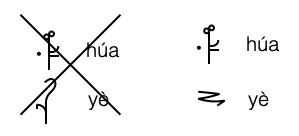
..
The main derivation pathways
..
Derivational morphology often involves the addition of a derivational suffix or other affix. Such an affix usually applies to words of one lexical category (part of speech) and changes them into words of another such category. For example, the English derivational suffix -ly changes adjectives into adverbs (slow → slowly).
Examples of English derivational patterns and their suffixes:
- adjective-to-noun: -ness (slow → slowness)
- adjective-to-verb: -ize (modern → modernize)
- adjective-to-adjective: -ish (red → reddish)
- adjective-to-adverb: -ly (personal → personally)
- noun-to-adjective: -al (recreation → recreational)
- noun-to-verb: -fy (glory → glorify)
- verb-to-adjective: -able (drink → drinkable)
- verb-to-noun (abstract): -ance (deliver → deliverance)
- verb-to-noun (agent): -er (write → writer)
Derivation can be contrasted with inflection, in that derivation produces a new word (a distinct lexeme), whereas inflection produces grammatical variants of the same word.
Generally speaking, inflection applies in more or less regular patterns to all members of a part of speech (for example, nearly every English verb adds -s for the third person singular present tense), while derivation follows less consistent patterns (for example, the nominalizing suffix -ity can be used with the adjectives modern and dense, but not with open or strong).
Derivation can also occur without any change of form, for example telephone (noun) and to telephone. This is known as zero derivation. [ All the above from "wikipedia" under "linguistic derivation" ]
..
The diagram below shows the ten main derivational processes which are absolutely fundamental to the working of the language. [Remember the base verb should be considered a noun]
[1]
Most nouns can be used as adjectives just by placing them directly after the noun they are qualifying. Like "school bus" in English. For example ...
pintu tìa = a/the door of the house
Also to indicate possession the possessee is usually just placed after the possessed.
tìa jono = John's house
(Actually there is a particle yó joining the possessed to the possessee ... however it is rarely used. yó is also a noun meaning possessions, yái an item possessed, yáu "to have")
"John's house" => tìa yó jono .... but more usually tìa jono
This is zero derivation and is marked as ![]() in the above diagram.
in the above diagram.
[2]
gèu = green
+ gèu = the green one
?azwodus = lactose intolerant
+ ?azwodus = a/the lactose intolerant one
[3]
gèu = green
k+ gèu = the green ones
k+ gèu làu oila = six green ones
sadu = elephant
k+ sadu = elephant-kind
k+ sadu làu oila = six elephants ... well, it is legitimate to say this ... but oila sadu is so easier.
[4]
gèu = green
kuwai gèu = greenness
[5]
yubau = strong
yubako = to strengthen
pona = hot
ponako = to heat up
[6]
poma = kick (also means leg) .... pomora = He/she is kicking
pomako = to kick ..... NOW kaupa = leg ... kipa = kick
However if the base noun ends in n ...
kwofan = bicycle
gàu kwofan = to (do) bicycle
[7]
pazba yubara "I am strengthening the table"
..
| pazba | yub-a-r-a |
|---|---|
| table | strengthen-1SG-IND-PRES |
ponara moze "I am heating up some water"
| pon-a-r-a | moze |
|---|---|
| "heat up"-1SG-IND-PRES | water |
[8]
tunheun kwofanaru "I will bicycle to the townhall"
..
| tunheu-n | kwofan-a-r-u |
|---|---|
| townhall-DAT | bicycle-1SG-IND-FUT |
[9]
This will be covered in detail in the next chapter. However here is a quick example ...
solbara moze "I am drinking water"
..
| solb-a-r-a | moze |
|---|---|
| drink-1SG-IND-PRES | water |
from the verb base solbe "to drink"
[10]
-s, -n, -a, -o take -is, all other endings take -s (including -ia and -ua)
saco = fast, sacois = quickly
pudus = timid (of an animal), puduʒis = timidly
yubau = strong, yubaus = strongly
..
.
For [7] and [8] if the root that is to be transformed is monosyllabic, then we need -ko as well as -r-. For example ...
..
bàu = man
bauko = to man (exact same meaning as in English)
baukara téu dí = I am manning this position.
..
gèu = green
geuko = to make green
geukara pazba dí = I am painting this table green
..
You can say, that for monosyllabic words [7] = [5] + [9] and [8] = [6] + [9].
..
..
Unadorned adjective can be used as nouns in many situations. Similar happens in many languages. For example ... klár gèu is ambiguous.
To disambiguate => klár kuwai gèu "I like greenness" / klár k+ gèu "I like the green ones" / klár + gèu "I like the green one"
.
The remaining two transformations shown on the diagram are for verbalization. Actually the affix -ko is added to all adjectives or nouns in order to make a verb. However in one circumstance this affix is not needed. This is for the r-form based on a multi-syllable adjective or noun. For example ...
..
pazba yubaku = strengthen the table (a command)
pazba yubakis = you should strengthen the table
..
ponaku moze = heat up some water (a command)
ponakos moze = he/she should heat up some water
..
bauku téu dí = man this position (a command)
baukos téu dí = he/she should man this position
naike = sharp : naikeko = to sharpen
keŋkia = salty : keŋkiko = to add salt ... when the adjective ends is a diphthong (and is non-monosylabic) the last vowel is dropped.
keŋkikara = "I am adding salt" .... note not *keŋkara ... this is because keŋkia is a derived word.
sài = colour : saiya = colourful : saiwa = colourless : saiko = to paint (maybe via *saiyako)
..
Note ... -ko is possibly an eroded version of gàu ( "to do" or "to make" ).
Note ... There seems to be a method of deriving a two place verb from a one place verb by affixing -n. For example ... diadia = "to happen" : diadian = "to cause". While this mechanism is seen all over the language I have not mentioned it in the chart above. This is because I consider it non-productive. I count daidia and diadian both as base words. In a similar way that English speakers consider "rise" and "raise" independent words, "lie" and "lay" independent words and "sit" and "set" independent words.
..
... Intensifiers
..
THIS MUST BE REWRITTEN .... TUGE = more : JIGE = less
Remember earlier in this chapter, we mentioned the numerative slot (for the senko). To recap, this slot can contain ...
yè "plural" ... aʔa "one" ... ima "two" ... uya "three" ... iyo "few" ... eja "four" ... ofa "five" ..... up to ..... afaufaifa "21510 ... hài "many"and ú "all"
Below is show how hài and iyo divide up the semantic space of quantity(intensity).
..
..
Now all saidau(adjectives) can be affixed by -ge to form the comparative* form. For example ...
bàu jutu = "the big man" : bàu jutuge = "the bigger man"
This affix can also be used with the numbers ...
juge "more than zero", a?age "more than one" : image "more than two" .... up to afaufaifage "more than 21510**
Now -ge can also be affixed to iyo letting us fill in every box of the chart given above ... 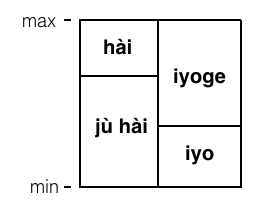
..
Now when attached to saidau, -ge gives a relative value (i.e. you are comparing one thing with another). However when -ge is attached to a numbers you get an absolute value (i.e. you are not comparing the modified item with anything).
When you want to compare two items as to their numerative value, you must use the particle yú.
(The word yú and the suffix -ge both can be translated as "more", however yú only qualifies nouns and -ge only qualifies adjectives)
jonos byór yú klogau jenewo = "John has more pairs of shoes than Jane"
?ár yú halmai = "I want more apples"
?ár hài halmai = "I want a lot of apples" or "I want many apples"
..
Now a number can immediately follow yú. For example ...
?ár yú léu halma = "I want three more apples"
yár yú halmai jenewo = "I have more apples than Jane" ....... [ note ... halma with léu but halmai with yú ]
..
To indicate "less" ... use wì. For example ...
jenes yór wì halmai pawo = "Jane has less apples than me"
jenes yór wì hói halma pawo = "Jane has two less apples than me" .... but it would sound better to rephrase these as ...
yár yú halmai jenewo = "I have more apples than Jane" : yár yú hói halmai jenewo = "I have two more apples than Jane"
..
*The affix -mo is the superlative for adjectives. When joined to hài and iyo ... we get "the majority" haimo and "the minority" iyomo
**Note ... the words noge, haige and uge do not exist.
..
..
Above we have talked about numeratives and in detail about how to quantify senko.
Below we will touch on how other categories of words have their own intensifiers ...
..
..
hài bàu = many men
moze hè = a lot of water
hè also can qualify verbs. As with normal adverbs, if it doesn't immediately follow the verb it must take the form hewe.
(Note to self : I can't think of a reason you would want to separate hè from its verb)
glá doikori hè = the woman walked a lot
hewe glá doikori = the woman walked a lot
báus timpori glá hewe = the man hit a woman a lot
And also can intensify manga and mangas
solbe hè moze = "to drink a lot of water"
solbe moze hè = "to drink a lot of water"
The above two forms are equally likely to be found. There is a difference in meaning but you would be a real nitpicker to worry about that.
..
saidau and saidaun are both intensified by sowe ...
jutu sowe = "very big"
jutun sowe = "the very big one"
..
Notice that mangan and saidaun can take two intensifiers ...
hài solben hè wiski = the many times a lot of whisky was drink ... hài solben hè wiski hí pà = the many times I have drunk a lot of whisky
hài gèun sowe = the many very green ones
..
We will take about the opposite of intensifiers and other quantifiers in a later chapter. These are a lot rarer. The intensifiers are the ones most commonly used.
..
... Index
- Introduction to Béu
- Béu : Chapter 1 : The Sounds
- Béu : Chapter 2 : The Noun
- Béu : Chapter 3 : The Verb
- Béu : Chapter 4 : Adjective
- Béu : Chapter 5 : Questions
- Béu : Chapter 6 : Derivations
- Béu : Chapter 7 : Way of Life 1
- Béu : Chapter 8 : Way of life 2
- Béu : Chapter 9 : Word Building
- Béu : Chapter 10 : Gerund Phrase
- Béu : Discarded Stuff
- A statistical explanation for the counter-factual/past-tense conflation in conditional sentences
